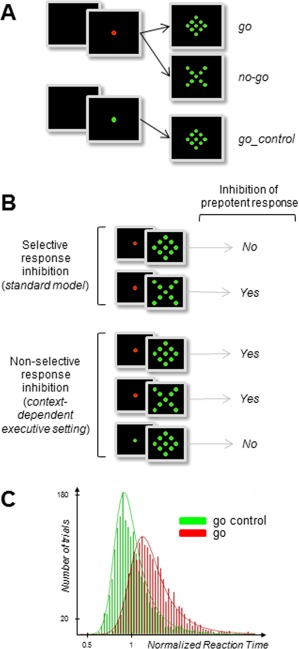Figure 1.

Protocol (A), models' predictions (B), and behavioral results (C). (A) Subjects were asked to react as fast as possible to a go stimulus (diamond) by means of a button press with the right thumb, and to withhold responses to an equiprobable nogo stimulus (X). In a control condition requiring no hypothetical inhibitory setting, only go stimuli were presented (go_control). In classical go/nogo tasks, go and nogo signals are scrambled within the same block of trials (standard mixed block design), assuming classically that inhibition is triggered by the nogo but not by the go stimulus. In contrast, an alternative view suggests that both stimuli induce automatic response inhibition in order to prevent premature responding. In other words, the usual nogo vs. go contrast would be incomplete to evidence all response inhibition mechanisms. To this aim, a control condition in which response inhibition is definitely not involved would be necessary (go trials for which subjects know in advance that there is no need to refrain from reacting). In the present experiment, this control condition was set by manipulating the color of the central fixation point (FP) of the display. A green FP indicated that not any nogo stimulus would be presented, enabling subjects to react automatically to any upcoming event (go_control condition). Conversely, a red FP was not informative of the identity of the upcoming target. (B) Strong, specific, predictions are attached to each hypothesis. The late, selective, account predicts that stimuli that have to be withheld (nogo) should induce specific brain activations with respect to stimuli that require a motor response (go). Conversely, the early, nonselective, account predicts that all stimuli presented in a context of uncertainty (both nogo and go) should induce inhibition‐related brain activations with respect to stimuli presented in a predictable environment (go_control). At the behavioral level, the standard model does not predict RT differences between go and go_control conditions. Conversely, the alternative model predicts that inhibition of automatic responses to any visual stimulus should lengthen RT in the red FP with respect to the green FP condition [e.g., Criaud et al., 2012]. (C) Normalized RT for go and go_control trials, pooled for all subjects. Distributions are best fitted by ex‐Gaussian functions. The RT difference between go and go_control trials reflects the effect of fast automatic response inhibition, a prerequisite for giving appropriate slow volitional response. Consistent with recent investigations using comparable methods and providing similar data and conclusions [Chiu and Aron, 2014], this major behavioral result fits the predictions of the automatic, nonselective, account of response inhibition.
